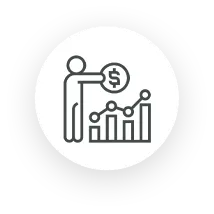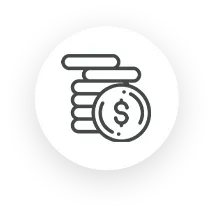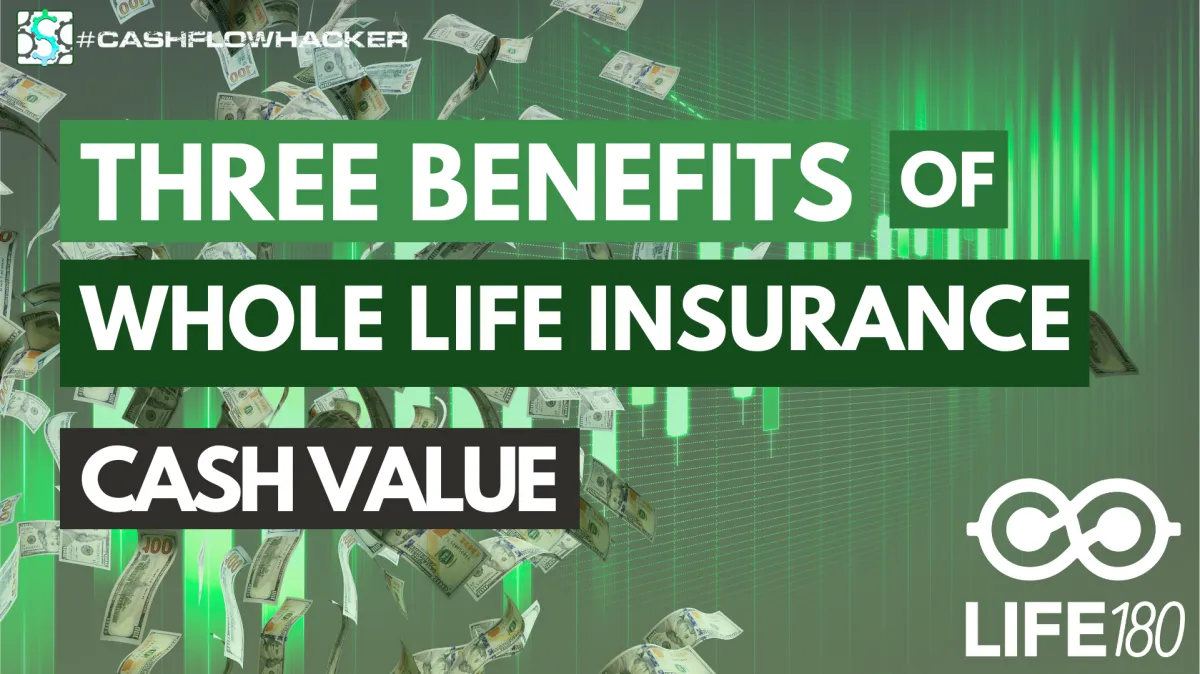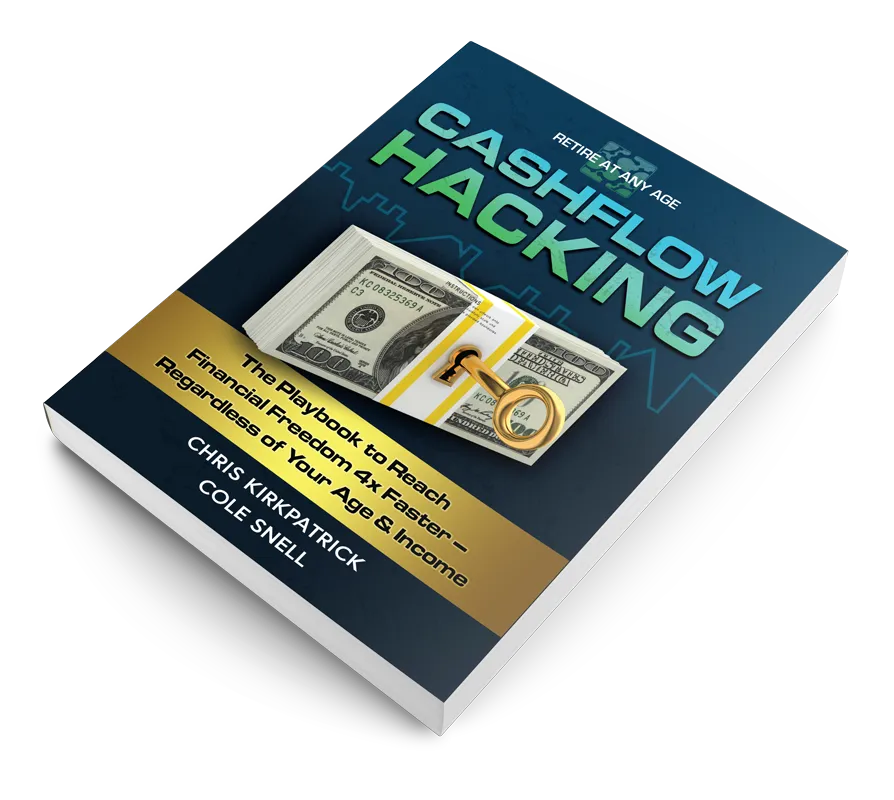
Simplifying Financial Confusion
LEARN CASH FLOW HACKING TO REACH FINANCIAL FREEDOM
Used by 90% of millionaires to reach their financial goals 4x faster

Achieve Financial Freedom Through Cash Flow Hacking

Increase Your Lifestyle While You Build Your Wealth

Position Yourself to Thrive in Market Downturn
YOU SHOULD NOT FEEL OUT OF CONTROL ABOUT YOUR FINANCIAL STRATEGY

Have easy access to your money in case of emergencies and opportunities

Use the investment strategy 90% of millionaires use

You deserve a clear plan to consistently grow your money and avoid market uncertainty

Have a guide and advisor that has your best interest in mind

Do not overpay in taxes

Stop guessing at the best vehicles to protect and grow your money

3 Benefits of Whole Life Insurance Cash Value
This article is based on the video that you can find on my YouTube channel Life180.
Accessing the cash value within your whole life insurance policy is one of the most potent features of whole life insurance in general. Unfortunately, there is a widespread misunderstanding of what whole life insurance truly entails and how it operates. Many mistakenly equate the returns from the cash value within a policy to those of an investment.
When you make this association, you fail to grasp the workings of whole life insurance and how it should function as an asset in your life. It's crucial to recognize that whole life insurance is not an investment; it should never be regarded as such or compared to traditional investments. However, this doesn't diminish the fact that access to the cash in the policy constitutes an exceptionally powerful asset in your financial portfolio.
In this article, I will delve into the discussion of the three major benefits associated with the cash value within your whole life insurance policy that you need to comprehend. I believe that gaining a thorough understanding of these benefits will reveal the true power of this asset at various stages of your life.
Whole Life Insurance Is a Savings Alternative, Not an Investment Alternative
When you grasp these three elements, it will significantly shift your perspective on the cash value, influencing how you leverage it and the diverse roles it can play in your life. This understanding will help break away from the misconception that whole life insurance is merely a poor investment alternative, as it fundamentally differs from traditional investments.
The primary aspect we should address here is understanding the purpose of the cash value in your life insurance policy. It's essential to recognize that whole life insurance alone does not generate wealth. The policy itself is not an investment; it does not function as an investment in any way.
It serves as a valuable asset, a reservoir or storage facility for your capital that you can deploy for other investments. It's crucial to emphasize that the investment does not lie within the policy itself, the account, or the cash value; rather, these components function as tools to facilitate and enhance your overall financial strategy. Understanding this distinction is key.
So, the question arises: what is the purpose of the cash value in this policy? The primary role is to serve as an accessible source of funds for emergencies, making it an excellent alternative for an emergency fund. It's essential to distinguish the cash in your whole life insurance policy as a savings alternative rather than an investment alternative.
The key distinction lies in the level of risk involved. Given the guaranteed returns and consistent dividends paid by reputable mutual companies for over a century, your money in the policy is secure. It becomes a secure haven for your capital, allowing you to manage long-term risk with a lower standard deviation than other investment options. This aspect makes whole life insurance policies a particularly safe and reliable place to safeguard your capital and ensure access to it when needed. Understanding this distinction is paramount.
From my perspective, the approach involves prioritizing the establishment of an emergency fund as the initial step. Following that, there's the potential consideration of building an opportunity fund, particularly if your skills and investor DNA align with such a strategy. This perspective becomes particularly relevant for individuals involved in real estate, entrepreneurship, or business ownership, where having access to an opportunity fund holds greater value.
On the other hand, if you fall into the category of a W-2 employee who may not actively pursue such opportunities, you might focus on utilizing your whole life policy to save and capitalize your emergency fund, redirecting additional investments towards other avenues such as stocks or other investments. The key lies in aligning your financial choices with your values and beliefs, irrespective of the specific investment route you choose.
Now that we've clarified that whole life insurance is not an investment but rather a savings alternative, the next step is to compare it to other assets with a similar risk profile. Understanding its role as a secure haven for capital, we can evaluate how it aligns with and stands up against other assets in terms of risk and stability.
Comparing Whole Life Insurance To Other Assets With Guarantees
Let's examine secure investment options. What are considered safe assets? Savings accounts, bonds, and CDs emerge as the top contenders in this category. Regarding savings accounts, money market accounts can offer returns of 5% to 5.4%, particularly for substantial amounts. High-yield savings accounts typically fall within the 4% to 5% range. Bond yields are on the rise, and CD rates are also increasing. The fixed market is currently showing signs of improvement.
What intrigues me is that I have some content from several years ago discussing whole life insurance as an alternative for saving money. Critics are pointing out what they perceive as a contradiction, asserting, "Don't you look foolish for claiming that whole life insurance would yield 5% to 5.5% in the long term, while bonds were only offering 2.5% to 3%?" Their argument continues with, "Now that bonds are returning 5.5% to 6%, you seem misguided. Whole life insurance is inferior, and that's why it's not a good option." That's essentially the sentiment expressed by these critics.
Ultimately, the dividends and returns within whole life insurance will follow the trends of the fixed market. As the fixed market experiences an increase, whole life insurance will trail behind but still rise in tandem. However, the primary reason for considering whole life insurance as a secure and easily accessible source for funds is the lower standard deviation compared to almost any other financial account.
What we need to consider here is the long-term perspective with savings accounts. While it may be true that people can currently achieve certain returns, the reality is that, long-term, even securing a 2% return in a savings account can be considered fortunate. If we reflect on most savings accounts from two or three years ago, they were offering around 0.1%. This highlights the importance of adopting a long-term mindset. I often emphasize the phrase, "You can't solve long-term problems with short-term thinking." As a 43-year-old individual, my focus is not on the next one to four years; rather, I'm concerned about the next 20 plus years. I anticipate needing access to this secure capital over an extended period, and my goal is to maximize returns during that time frame.
I acknowledge that the interest rate environment will fluctuate, experiencing both lows and highs over time. My objective is to smooth out that curve. There will be instances where the returns on my whole life policy might be less favorable than those in the market, but there will also be times when the returns on my whole life policy surpass what I would receive from bonds or a savings account. Ultimately, when evaluating a whole life policy, it proves to be more liquid than bonds and is approximately as liquid as a savings account.
Whole Life Insurance Provides Bond-Like Returns, Muni-Like Taxation, & Money Market Liquidity
I want to emphasize the three key benefits, as they encapsulate the real value that you need to comprehend for the long term. The first benefit involves bond-like returns with a lower standard deviation than traditional bond portfolios, which have faced significant challenges in recent years. The 60-40 portfolio, with bonds comprising 40% of it, is currently suffering due to an unprecedented situation where bonds are losing money alongside the market for two consecutive years. This is resulting in severe losses for people's retirement accounts.
The second significant benefit is the municipal bond-like tax treatment. Your money will grow tax-deferred, and you'll have tax-free access to it within your whole life insurance policy, an incredibly powerful advantage.
The third benefit is money market-like liquidity. When we consider these three advantages, the combination of bond-like returns with a lower standard deviation than a bond portfolio is already powerful. What makes it even more compelling is the added dimension of liquidity, similar to that of a money market account. This unique combination provides the best of both worlds, long-term bond-like returns coupled with short-term money market-like liquidity. Additionally, we leverage the Muni bond-like tax treatment to enhance the overall value.
When you combine these three elements and intertwine them, and then consider the additional layers such as the life insurance backstop and the living benefits riders, though not the focal point of this article, there's a substantial impact. Particularly, when you factor in the ability to utilize this as a bond alternative in your life, replacing the bond segment of your portfolio during retirement becomes a strategic move.
This approach, coupled with the death benefit and living benefit riders, is not only a sound strategy but also provides enhanced protection during retirement. It significantly influences your ability to create a predictable retirement income and plan more effectively for the market's fluctuations.
The reality is, for a couple retiring at 65, there's a 25% chance that one of you will live to at least 92 years old. This means you need to plan for your money to last for about three decades. If your financial setup doesn't account for this extended time horizon, there's a significant risk that you might need to make a substantial reduction in your standard of living during retirement.
If You Consider Whole Life Insurance in This Way, It Always Makes Sense
I analyze this situation and it just makes sense to me. If we recognize that comparing whole life insurance to an investment is inappropriate and instead view it as a savings alternative, we can then consider its alignment with our immediate needs. Currently, there may be short-term requirements such as an emergency fund or a need for liquidity. During the savings years, especially when supporting a family, there's likely a desire for life insurance. However, as one transitions into retirement, the nature of the asset shifts, and it transforms into an alternative to bonds in terms of utilization.
You have this singular asset that can address various needs at different phases of life, as long as you approach it not as an investment, but rather as a foundational asset capable of tackling a range of challenges as you navigate through life. The only way to hinder its effectiveness is by not engaging with it, not taking advantage of it, and not saving, a crisis in itself. There's currently a significant savings crisis in the country, and it serves as a major contributor to many of the issues we face.
So, hopefully, this provides assistance and clarity, offering insights into the diverse ways you can utilize whole life insurance. It's crucial to comprehend how the cash value operates and grasp the benefits, taking into account the various components and features of that cash value. This understanding is vital because, with this knowledge, the appeal of whole life insurance is likely to grow for you.
If you have any lingering questions and would like to engage in a conversation for further clarity, I encourage you to schedule a clarity call with someone from my team. It's not a sales call; rather, they will assist you in addressing any questions you may have. If it seems sensible to collaborate, whether it involves obtaining a policy or making decisions based on your specific circumstances, we can explore those options. The primary objective is to provide you with the education necessary to make the most well-informed decision for yourself.
So, if you found value in this, please consider sharing the article to spread the knowledge. Until next time, have a blessed and inspirational day.
HOW TO START TAKING CONTROL OF YOUR FINANCES BY MAXIMIZING YOUR CASH FLOW AND PROTECTING YOUR ASSETS

1. Schedule Your Free Clarity Call

2. Create a Free Customized Plan

3. Get Guide to Financial Success
GET YOUR FREE COPY TO STOP USING OUTDATED RETIREMENT STRATEGIES
Cash Flow Hacking teaches you to:
Protect Your Investments
Thrive in bad markets
Reach financial freedom faster

ARE YOU LOOKING FOR:

Cash Flow Hacking teaches you to:
Security to protect your money
Increased cash flow and lifestyle
Inflation protection
Financial certainty in all economic environments
A reduction in taxes
Safe and fast access to your money with no penalties
WHO IS THIS PROGRAM FOR?

People looking for an alternative
Are you looking for alternatives to Wall Street’s “buy and hold” strategy that takes 40 years with uncertain results? Our Cash Flow Hacking strategies provide you the building blocks to get started on the right foot

Passionate Entrepreneurs
Are you looking for a financial strategy that will take your best assets (you and your businesses) and multiply their potential? Our Cash Flow hacking strategies will teach you how to invest for the future without sacrificing building your business

Real Estate
Investors
Are you a real estate investor who is burned out from being a landlord or playing the fix-and-flip game? Our Cash Flow Hacking strategies will provide you with the system to create predictable wealth AND give you the freedom you are looking for.
YOU DESERVE PEACE OF MIND AND A PLAN THAT WILL PROTECT YOUR FAMILY AND GROW YOUR WEALTH
Today you need to be more savvy than ever if you try to go at it alone.
Losing money to inflation, taxes, and just poor investment strategies is leaving you frustrated, feeling out of control and not knowing where to turn. To add to the problem, the market is flooded with advisors who have outdated advice that does not place your best interests first, but instead focuses on charging you a fee that creates guaranteed cash flow for them.
NOT YOU
We believe this is wrong and that your security and best interests should be placed first. We believe you should be in a position where you control your money, your money doesn't control you. We understand because we talk with hardworking people everyday that are losing money in the markets based on old information and feel like they are guessing at the best course of action.
We created the Cash Flow Hacking plan to help you have security and control of your money to take advantage of life's opportunities because you deserve peace of mind with your wealth. The old way of planning for retirement of… Go to school Get a job & save as much as you can in your 401k and mutual funds...is broken.
You have been lied to. Think about it, where else in life does someone tell you that the most certain way to achieve your desired result is to take on more risk? The math just doesn't work, and the results are showing in our country and world. Did you know that 90% of millionaires in the United States have 1 asset in common?
Hint: it's not stocks or mutual funds (and no...it's not crypto) How much sense does it make for you to work hard, save money, reduce your current lifestyle (because that's what you are doing when you save for the future - taking money you could use on lifestyle today and delaying gratification to a future unknown time), and hope that whatever you are doing will work three to four decades from now? If you're thinking, "not much sense at all…", you are in the right place.
With over 50 years of experience on our team, we have worked with thousands of individuals and families to achieve financial freedom faster and with more predictability by helping them invest for Cash Flow.
How does the Cash Flow Hacking Plan work? 1. Take the Cash Flow Hacking Challenge 2. Complete the LIFE180 X-Ray and determine what your Freedom Number is 3. Work with a Cash Flow Hacking expert to provide you a customized plan
The customized Cash Flow Hacking plan will give you clarity on where you are now, where you want to go (and in what time frame), and what you need to do to get there predictably.
We value and commit to you: We believe you deserve the best financial education and guidance We believe financial decisions should not be rushed but be well thought out with a plan We believe you should be in control of your money We believe we earn your trust through time, education, and proper due diligence Without a proper plan and guidance, your money can be lost to taxes, inflation, and bad investments You deserve more with the most up-to-date strategies to mitigate your risk, control your money, and earn stable returns regardless of the market Schedule a call here to attain your LIFE180 Financial X-Ray now or get started with the Cash Flow Hacking Challenge for free.
I am interested in...